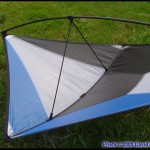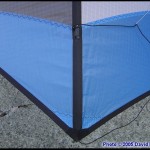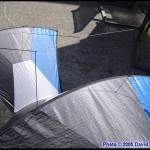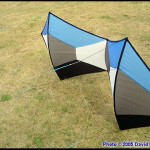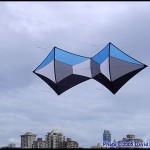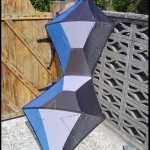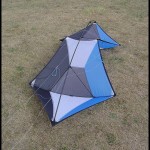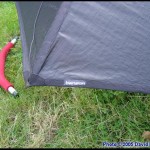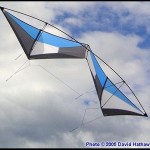 Specifications
Specifications
Manufacturer: Benson Kites
Model: Airbow
Wingspan: 2.15 meters / 7.05 feet
Weight: 230 grams / 8.25 ozs.
Type of kite: Quadline kite with secret Dual leanings
Materials: Custom Skyshark 8P, 4mm carbon rod and tube, Icarex
Source for test kite:Benson Kites
When I picture a Benson kite, a few things come to mind. Visually striking, flawless construction and state of the art design, a kite that pushes the envelope. And I’m pleased to report that The Airbow is no exception, in any way.
Originally designed by Andy Wardley and made by Benson, they are a rare sight at this point in North America, which I suspect is due to the price once its converted from Euros back to the US dollar. In the UK, its retail is 190 pounds, which as of today is roughly $350 in US funds (and even more in Canada). Thats not to say the kite is overpriced, its certainly fairly priced given the construction and materials, but, its certainly going to be one of the more expensive kites in your bag.
Quality of Construction
Talk about a well built kite! As I suggested above, Benson kites are always really well made kites, from the basic design details to the sewing and the visual design. The back rod is made from a 2 piece custom Skyshark 8P rod. The middle of one of the rods is ferruled, and fits nicely through the center piece to connect up to the other rod. This forms the main tensioning rod for the entire kite and once assembled completely, it has a slight bow to it. Each of the corner tips has an angled pocket that the rod slips into snugly. The rest of the rods (3 vertical and 4 rods to connect 2 of the vertical spines back to the long back rod) are made from 4mm carbon rod and tube. The verticals are always attached to the sail itself, whereas the other four are put into place to bow out the sail. Nicely tipped, if you are careful, you won’t put one through the sail when assembling or disassembling. The connection points for the 4 rods are strong rubber and look like they would last a long time. The sail itself is Icarex and its well reinforced with small mylar patches on the corners. All of the versions I have seen have been a variation on 4 colours, with black on the bottom, two shades of grey to make up the boxes and a colour on top, light blue on this review kite. One of the first things you will notice with this kite in the air is that its a very striking design on the sail. It reminded me of the somewhat 3Dish box that is on the Benson Box Of Tricks kite. Its like a simplified Escher design, which makes whats already a 3D sail into an even more pronounced depth and effect. Numerous people who hadn’t seen one before would simply look up and stare at it as the boxes rotated around the sky with a smile on their face and I caught myself staring as I slowly rotated it around.
When I first pulled this kite out of the bag, my first thought was “oh no, here comes another highly tensioned frame like a Synergy-Deca kite” (of which I have broken a few). But, assembly was trivially easy, even if you didn’t glance at the instructions. Even a monkey could build this kite! You start with putting the back rods together, which fits without wrestling, and then insert the 4 rods to push out the sail, and thats it. The 4 rods that attach to the vertical spines and back rod are a little tight to fit initially, so, take care as to how you do this or you may put one through the sail with a bad slip. My recommendation is to attach these to the vertical spine connectors first and then seat onto the back rod connectors. This will really minimize the chances of sail damage. After a few flights, they begin to loosen up enough so that they fit a little easier, but, still snugly. Attach 4 equal length lines to the kite and then to the handles and you are ready to fly. Also, taking this kite apart when you are done is just as easy, simply remove the 4 rods first, and then take apart the back spine. Again, my recommendation with the 4 rods is to unhook the back spine connections first, and then remove from the sail, just to be safe.
Bridle
Its a little tough to describe this bridle as its very specific to the kite itself, thus there isn’t much to compare it to. Its symmetrical, much like the kite is, and basically presents a rectangle against the kite sail. There is also a line connecting the center of the two side pieces. The bridle connects to two points on each of the sail vertical rods. I couldn’t discern any adjustment points, but, unless Andy wants to tell me differently, there probably isn’t much you would want to adjust with this beyond making sure all the line segments are equal on both sides of the kite. Lastly, the handles that come with this are unique as well. They reminded me of traction kite handles that were much lighter. The handles are symmetrical in design though the bottom tie points are about an inch longer than the tops for adjustment purposes. The grey ones are the top, the black ones connect the bottom. While you can use any quad handles with this kite, you’ll find that the Benson ones have some advantages to them that are specific to this kite. I found my hands would switch which end of the handles they were at, depending on which direction I as spending more time, and they make this very easy to do.
Wind Range
The stated wind range for this kite is 3-18mph, which proved to be reasonably accurate. In anything less than 5, its still flyable, but, much of your time will be spent hauling it up into the sky (its much like the dual line pumping actually, more on that later). With further experience flying, I’m sure 3 mph becomes a better experience. I had this kite out 3 times during this review, once at WSIKF in an 3ish breeze and the other two times were between 5 and 10mph. At these speeds, the kite stays up in the air easily (provided you have the basics of quad flight under your belt already) and you can take it through all of its tricks.
I also managed to fly it on a few different line lengths, 50, 75 and 100 feet. As you’d expect, its a little quicker to react on 50 feet lines, but, its not unmanageable. 75 feet seems to be its sweet spot for line length with this kite.
Unusual Flight Behaviors
Lets get this out of the way first of all. When you are reviewing a quad kite, the first question will always be “so, how does it compare to a Revolution?”. I’m going to quote a british chap (named Brian Fattorini, see link below) who has written about Airbows a few times, as he sums it up perfectly :
“The short answer is that it doesn’t, it is completely different and in a parody of Douglas Adams’ line from Hitch Hikers Guide to the Galaxy I would say that “it flies through the air in exactly the same way that a Rev doesn’t”…
That captures the essence of this kite and this is a plus in my eyes. The first time I flew it in a decent wind, I ran it through everything I’d usually do with a Rev and had a fine time doing that. Its a capable flyer in this regard though I found its precision turn ability a little lacking. I put this entirely on my newness with the kite, I’ve seen videos of Airbows flying very precisely so, I expect its simply a matter of putting in the time on this kite. Dive and Stop, forwards and backwards, its all easily pulled off. One very definite difference is its behaviour in reverse, specifically, there is no physical difference between flying in either due to the utterly symmetrical design of the kite and handles. In this, it reminded me a lot of Guildwork’s Synergy-Deca kites and their similar flight behaviour though one big plus in the Airbow’s favour is the differing colours for the bottom and top of the kite. It makes it very easy to know which direction you were going in, something that always gave me fits when flying Decas.
The walk of shame is a non issue with this kite. I found that there were few positions in which this kite wouldn’t launch from, whether it was upside down, backwards, with a side facing you or any other odd landing. A quick tug on the proper line and you could right the kite around and take off again. The only times I had to walk up and deal with the kite after a weird landing was due to oddball line tangles (which, will happen in ways you have never imagined occasionally). This was very infrequent and usually the result of a rollup that had gone awry.
Flight photos by David Hathaway
Strangest Tricks
“Did he just say “rollup”?” Why yes, yes I did. One of the things that really makes this a unique kite. Not only does it respond well to quad line hand movements, you can also use dual line skills as well and for this kite, that opens up quite an array of motion that you can’t do with any other quad line kite. For example, put the kite up into the air, hover and start your traditional Rev “spin in one place” move. Now, start to exaggerate that motion by pulling your hands way back and the kite will nearly flatten out on its axis. It looks very much like a barrel roll. With this same approach to flying, the push/pull of dual line flying, you’ll find all kinds of neat things this kite will do. An entirely respectable axel is possible and a pretty spectacular cartwheel from side to side can be done.
Most Challenging Tricks
I did allude to rollups and its one of the niftiest tricks in this kite’s repertoire. There seems to be a few ways to this particular trick, but, I only managed to get one method down during the review time. As the kite reaches the top of the window, give it a sharp tug on the top two lines and start running forward. The kite will then roll around on itself or seesaw back and forth really nicely and mostly controllable.. Most of the time, getting out of this simply required a quick snap on all four lines and it was back to normal. Cal and I amused ourselves for quite a while with this, and at the bottom of this review will be a link to others doing it. There are also a few videos of Cal attempting to flic flac and yo yo the kite. I included a couple of bloopers too, simply because this kite will manage to get a few laughs out of you as you try to master it.
Summary
I always figure that in any given review, you have to find some negatives about whatever you are reviewing, but, in this case, I’d be struggling. Its a well built kite, a unique design and truly a lot of fun to fly. I have two negatives, and I’m quite willing to admit that they are lame ones.
First, if you are looking for a new take on Revolution style flight, this isn’t the kite for you. Bring your dual line skills into play and this kite opens up a new dimension of tricking fun. Secondly? Especially if you live in Canada, where this kite would probably come in around 400 or so Canadian dollars and it seems to be about 350 US dollars at the moment, its a pretty expensive kite. On it’s home turf in the UK, the price is comparable to Revs and most dual lines but, here, its getting up there, at least in my eyes. My advice with this would be to find someone who has one and fly theirs first to get a feel if this kite is for you. Its sufficiently “different” that spending a few hours on it, especially alongside of someone who can fly it well will make up your mind for you.
Looking for something different with four lines? Go get an Airbow. One thing that was very apparent with this kite is that the surface has only been scratched with respect to what it will do, given its only been available for about two years. When you look at where Rev flying was in 1991 and compare it to where its gone since then, I’d expect you will see similar things happen to Airbows as they get into more people’s hands. My hat is off to Andy Wardley for a truly original design. Can we keep this one out here on the West Coast?
Some Airbow Resources to help you along…
Aeolian.co.uk website – Excellent look at flying an Airbow by Brian Fattorini, this series of articles follows Brian through his learning curve.
Specifically the video of him taking an Airbow through all of its moves:
http://www.andywardley.com/kites/movies/jul2004.html
And lastly, a video from 2003 of Andy, on a prototype Airbow:
http://media.aeolian.co.uk/2003/airbow.mpg


